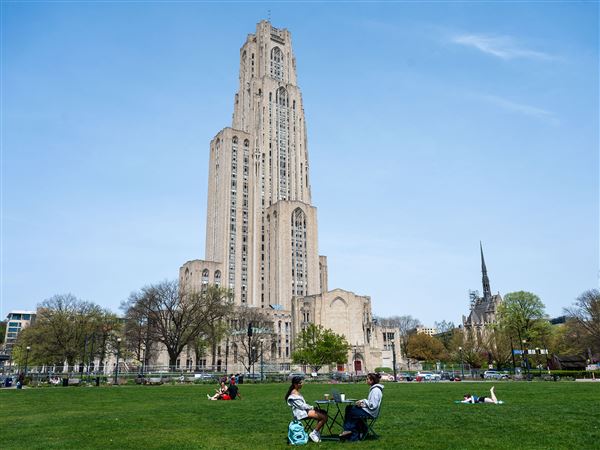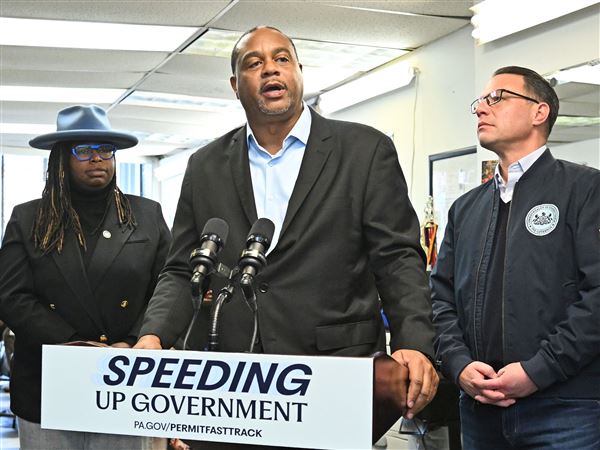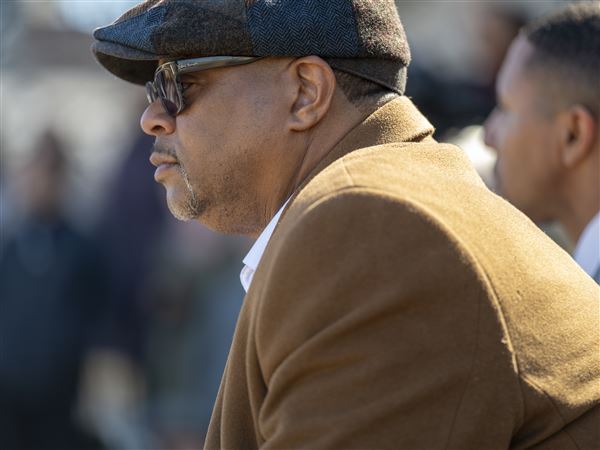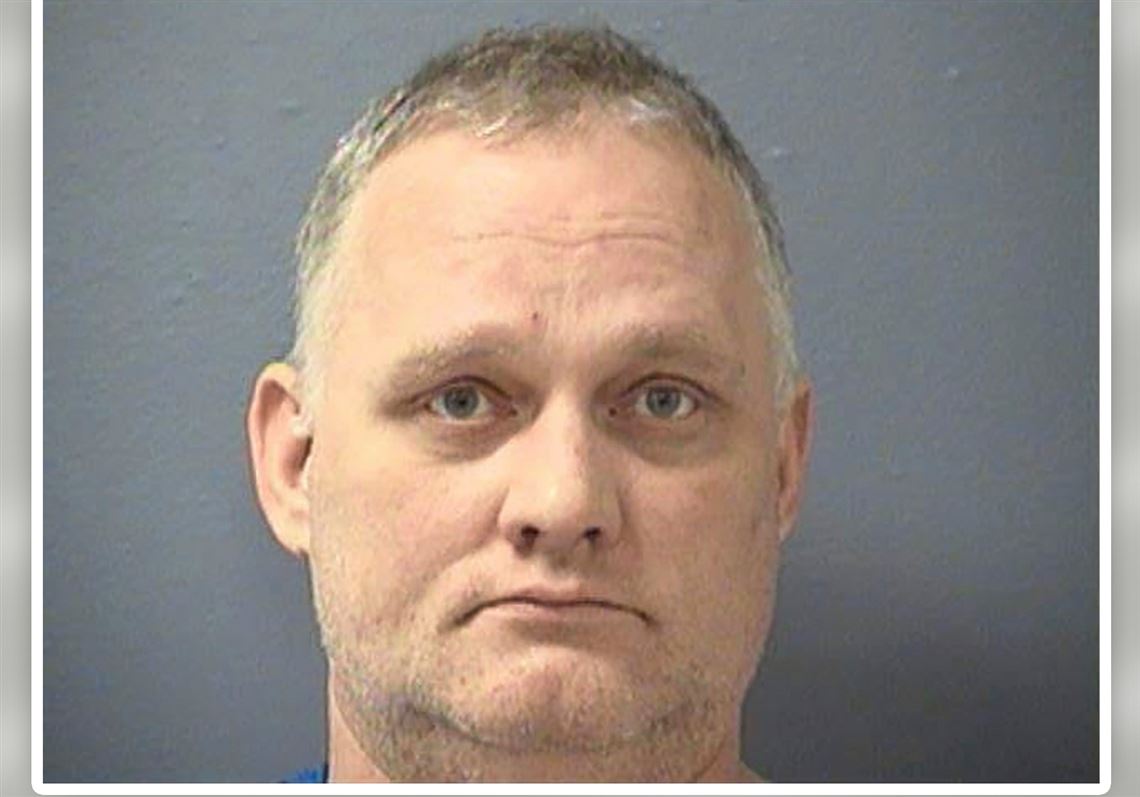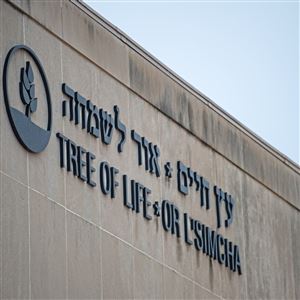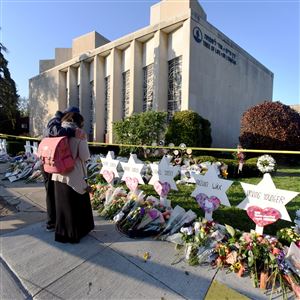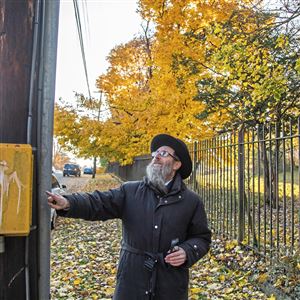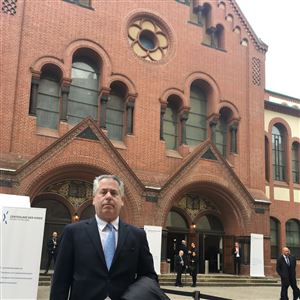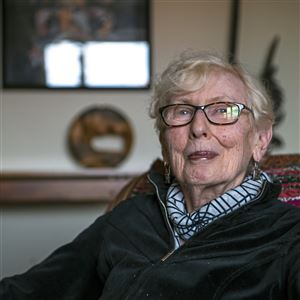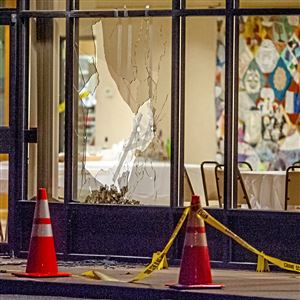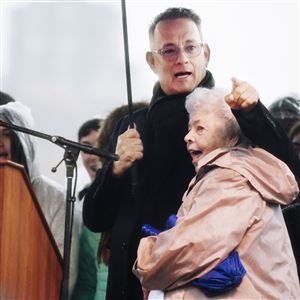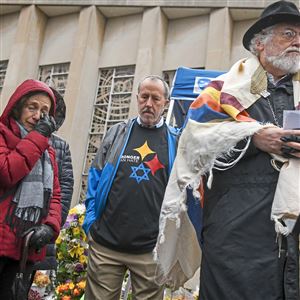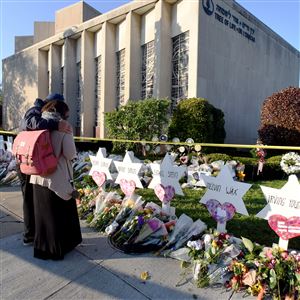This story was written by Rich Lord, based on his reporting and that of staff writers Liz Navratil, Michael A. Fuoco, Christopher Huffaker and Paula Reed Ward.
When Robert Bowers came to work at Dormont’s Potomac Bakery in the early 1990s, he struck his colleagues as a guy who liked beer, Hooters, action films and guns, with a bit of an anti-government streak — not as a virulent anti-Semite primed to explode.
“He wasn’t like that back then, with the hate,” said Robert Walters, 50, of Beechview, who described himself as Mr. Bowers’ best friend for around a decade, ending in 2004. “He was a happy dude.”
There were, however, hints of paranoid theories and violent thoughts.
“He had a shotgun right at the door,” said Patrick Kelly, 54, of Dormont, who also worked at the bakery and lived in an apartment atop it, across the hall from Mr. Bowers, for much of the 1990s. “And if the [United Nations] blue hats or tactical [team] came to get him, he said, they’d be decked out in [body] armor,” so he practiced aiming the shotgun at face height, said Mr. Kelly.
Now Mr. Bowers, 46, of Baldwin Borough, is charged with 44 federal counts in the Tree of Life massacre, which authorities have designated a hate crime, as well as 36 counts in state court, including 11 homicides of mostly-elderly worshipers at the synagogue.
Accounts from Mr. Bowers’ coworkers of two decades ago, and an analysis of his social media posts in the weeks prior to the massacre, suggest that staunch conservatism metastasized into white nationalism. First fascinated with conservative radio host Jim Quinn, he later became a follower of aggressive online provocateurs of the right wing’s fringe.
According to experts who study extremism, the Internet and social media have created new pathways from strident ideology to radicalism. Efforts to address that by shutting down social media sites can backfire, some experts said, calling for a subtler, but comprehensive approach.
“For the last several years, analysts have warned that these kinds of conditions would lead to these kinds of actions," said John Horgan, a professor at Georgia State University's Global Studies Institute and author of The Psychology of Terrorism, published in 2014. "I genuinely fear that we are seeing the culmination of something that has been boiling over for some time now. ... And I fear that we’re not prepared for it.”
Growing up, going in
Public records suggest that Mr. Bowers’ early years were bumpy ones. While the vast majority of people with fractured family lives and early exits from formal education don’t radicalize, research shows that the bulk of violent extremists come from such backgrounds.
His mother, born Barbara Jenkins and now Barbara Bolt, filed for divorce from his presumed father, Randall G. Bowers, when Robert was not yet a year old. In 1975, in Florida, she married again, this time to Robert W. Saiter. Though that marriage didn’t formally end until 2004, her divorce filing indicated that they hadn’t lived together since 1976.
It's not clear whether Robert Bowers had an ongoing relationship with either of his mother's first two husbands. Neither Mr. Bowers nor his relatives have accepted interview requests.
Randall Bowers committed suicide in October 1979, as he faced charges in an attempted rape in Squirrel Hill. Robert was 7 at the time of Randall’s death. A man appearing to match Mr. Saiter (including birth month, middle initial and previous addresses) was charged with molesting two girls, ages 5 and 7, when he was living in Hamlet, Ind., in 1987. He pleaded guilty and served around six years in prison. He could not be reached for comment.
Robert Bowers left Baldwin High School in November of his senior year, and his modest academic resume gave him limited job options. He found work delivering baked goods to customers including hotels, delis and country clubs. “He didn’t mind it,” Mr. Walters said.
“Bob came in and went straight down to do his job,” said Mr. Kelly, who was a baker and delivery driver. Whether Mr. Bowers was entering the delivery van or the bathroom, he often used a military-style saying, uttered in a half-joking manner, per Mr. Kelly: “He always used the term, ‘I’m going in.’”
Entering The Warroom
Mr. Bowers fit in at the busy bakery, picking up the nickname “Babs.”
“My kids always called him Uncle Babs,” said Mr. Walters, who often hosted his friend for action movie nights, chess games, and holiday celebrations. Mr. Walters said that Mr. Bowers didn’t talk much about his family, or politics, and didn’t show animosity toward Jews or any other group.
“I don’t believe he was that anti-Semitic, because we had a couple of Jewish people working for us,” and Mr. Bowers never seemed hostile toward them, said Mr. Kelly. Did he use the anti-Jewish slurs that later showed up on social media accounts associated with him? “I never heard him say anything like that.”
“He was a pretty well-rounded person back then,” said Mr. Walters. “We had good, clean fun. … We went to Hooters [restaurant] a lot,” at Station Square, for lunch and drinks, he said. He said Mr. Bowers drank moderately and dated women, but never stayed with one for very long.
If Mr. Walters’ car was down, and he needed a ride, Mr. Bowers would pick him up in his Plymouth Roadrunner. “Anywhere I needed to go, he’d take me.” Mr. Bowers also took his friend to his favorite target shooting spots — undeveloped land out past Century III Mall, and state gamelands in the North Hills.
Mr. Walters said that Mr. Bowers asked the bakery not to deduct federal income levies from his pay. Why? “He hated the government,” said Mr. Walters.
Mr. Bowers didn’t talk politics much, but “always referred to the blue hats, the U.N.,” said Mr. Kelly. The term “blue hats” was common in right-wing conspiracy theories, which held that United Nation’s forces were poised to disarm U.S. citizens upon the creation of a global government.
At some point in the 1990s, Mr. Bowers started listening to the Quinn in the Morning show, also known as The Warroom.
“He listened to Jim Quinn all the time,” said Mr. Kelly. “Oh, my God, that was his God!”
Internet domain records show that Mr. Bowers created a website, onedingo.com, and intended to archive Mr. Quinn's broadcasts there. In 2000, according to records of Mr. Quinn's site warroom.com, the show's "sound guy" was "Rob," with the email address warroom@onedingo.com. Archived versions of warroom.com credit "Rob Bowers" with the "encoding" work.
Mr. Quinn has not responded to interview requests from the Pittsburgh Post-Gazette, but told The Washington Post that he does not recall meeting Mr. Bowers, who was a volunteer for the company that ran warroom.com. Mr. Quinn's co-host, Rose Tennent, repeatedly declined requests to talk about Mr. Bowers.
The company that ran warroom.com around 2000, according to online archives, was owned by Cynthia Randazzo, of Edgewood. She declined to be interviewed about Mr. Bowers, but texted, "He was never on the payroll and I never met him in person!"
The role as Mr. Quinn’s archivist “was kind of a big deal” to Mr. Bowers, said Mr. Walters.
Mr. Bowers’ hostility to the United Nations was consistent with Mr. Quinn’s ideology. The site warroom.com today includes "Quinn's Laws," including this one: "13. The United Nations is an expensive farce that allows tyrants to park illegally and pretend that they are legitimate World Statesmen. They are not, they are thugs in $4000.00 suits who see America as the biggest threat to the world (eg: threat to THEIR utopian plans to control everything)."
The site also includes these "Rules of War: a. War is the only effective means for defeating evil. b. In war there is no such thing as excessive force. c. Using only the amount of force necessary to win, insures that you will lose. d. The U.N. does not prevent war. It prevents war from working by stopping it before there is a definitive result."
Talk radio “can be very influential in terms of getting a person moving in a certain direction," said Peter Simi, a professor of sociology at Chapman University in California, who has studied extremist groups for 20 years and is author of the forthcoming book American Swastika: Inside the White Power Movement’s Hidden Spaces of Hate. The vast majority of listeners, he noted, do not move on to violent extremism. But for a tiny few? “It’s an entry point of sorts to a world of ideas."
Online and off the radar
Mr. Bowers built his own computers and used the Internet long before it was a part of everybody’s daily life, according to Mr. Walters and Mr. Kelly. “He was an electronics expert,” said Mr. Kelly.
By 1998, according to online registries, Mr. Bowers even had a special account allowing him to send encrypted communications.
If talk radio is a path to strident ideology, the Internet is a "much more dynamic” path to the extremes, said Mr. Simi. "It is just creating this reinforced echo chamber where you’re just getting these like-minded sources of information that are consolidating and coalescing and pushing you in this direction.”
Because online advertising and social media feeds usually respond to the person's web searches, clicks and posts, the Internet can slowly draw a person from a strident ideology toward full-blown radical thinking, said Mary Beth Altier, an assistant professor at New York University’s Center for Global Affairs, who is writing a book about political violence in democracies. If a person’s background and life events are such "that this ideology is resonating with you, it can take you further and further down that path.”
After he quit the bakery around 2002, Mr. Bowers bounced around the South Hills, found work in over-the-road trucking, and cut some old connections.
He lived in Mount Washington, then with relatives including his now-deceased grandfather in Whitehall, before moving to a low-rise apartment building with peeling paint in Baldwin Borough. Neighbors from recent years said that he didn’t talk much or attend informal block parties. And his bakery colleagues no longer heard from him.
“Once he left the bakery, it seemed that he dropped off the radar,” said Mr. Kelly.
“I looked on Facebook for him,” but didn’t find him, said Mr. Walters, who left the bakery around 2004. He didn’t think much about his old friend for years, until Oct. 27.
“I was floored when I heard that it was him,” he said. “Something happened that made him go off the deep end.”
Riding with “Pale Horse”
Mr. Simi remembers when it was possible to track nearly all of the nation’s purveyors of extreme speech. That time has passed. “Holy moly, there are so many of them now,” he said. “There’s so many figures now to pay attention to. Some of these people on Twitter have an amazing number of followers. … It’s really frightening, to be honest with you.”
Budding extremists “find a sense of belonging in these chat rooms or radio shows or whatever they’re engaging with online," said Ms. Altier. "It kind of gives them a sense of purpose, especially if their career is going nowhere” and “helps them make sense of personal crises they've experienced, or a lack of achievement.”
Among Mr. Bowers’ apparent influences was an extremist who goes by the pseudonym Jack Corbin, or, sometimes, Pale Horse. That’s the person whose posts Mr. Bowers shared most often, according to the Network Contagion Research Institute, a group of scientists and engineers who use computing tools to expose hate speech online, and who have, since Oct. 27, been poring over the Baldwin man’s activity.
The Jack Corbin posts are many — two Twitter account associated with that name, created last month, were approaching a total of 3,000 posts last week — and often target perceived anti-fascist, or left-leaning, figures.
For instance, the Jack Corbin persona targeted students at the University of North Carolina Chapel Hill who were demanding the removal of a Confederate monument known as "Silent Sam," according to Lindsay Ayling, a graduate student who was involved in protests related to the statue.
Ms. Ayling said that since August, Jack Corbin has posted comments on her looks, ethnicity and background, targeted her friends with "really explicit and misogynist” posts, and chillingly made "a lot of references to the make and model of the car that James Fields drove through the crowd at the Charlottesville rally.” Mr. Fields, of Maumee, Ohio, faces 30 federal counts and state murder charges, accused of driving a 2010 Dodge Challenger into a crowd of counterprotesters and killing 32-year-old Heather Heyer after the 2017 Unite the Right Rally.
Ms. Ayling said she’s worried that the online attention could escalate violence, and has taken up cardio kickboxing. Learning that Robert Bowers was a fan of Jack Corbin heightened her concern.
During October, according to archives of activity on the right-leaning social media site Gab.com, Robert Bowers, using the handle onedingo, authored or shared apocalyptic post after post.
He shared material on the Christian Identity movement, which holds that people of European descent are the "chosen people," Jews are their enemy and other races are meant to be exterminated or enslaved. He also shared warnings of a coming "false flag" fake attack which would be "one of the final desperate attempts by the jewish [sic] international oligarchy to maintain power in the face of collapsing public trust" in the media.
Network Contagion Research Institute director Joel Finkelstein said there was little or no pushback from others on Gab.com when Mr. Bowers posted or shared anti-Semitic and anti-immigrant slogans and memes. There was plenty of encouragement.
Since mid-2016, the number of anti-Semitic comments on far-right social networks has nearly doubled, according to an analysis of 100 million online posts and tens of millions of images which the institute released in September.
In the weeks before the Oct. 27 massacre, Robert Bowers shared memes about the “caravan” of Central Americans moving through Mexico, and began posting on the "mass migration" of immigrants and refugees, sometimes blaming Jews. He zoomed in on HIAS, formerly the Hebrew Immigrant Aid Society, which helps federally approved refugees of all faiths to settle in the U.S. Referring to HIAS, he posted: "You like to bring in hostile invaders to dwell among us?"
A week before the attack, he reposted a message that Western civilization is "headed towards certain extinction within the next 200 years and we're not even aware of it."
Finally, just before the attack, he posted: “HIAS likes to bring invaders in that kill our people. I can't sit by and watch my people get slaughtered. Screw your optics. I'm going in."
Massacres “every other week?”
On Oct. 27, according to law enforcement, the 6-foot tall, 225 pound Robert Bowers parked in a handicapped space in front of Tree of Life synagogue. He left a shotgun in the car, brought his Colt AR-15 rifle and three .357 Glock handguns into the Tree of Life synagogue, and fatally shot 11 worshippers, ages 54 to 97, before firing on responding police, according to the criminal complaints against him.
If the accusations are accurate, what does that make Mr. Bowers?
"I would say, a terrorist," said Mr. Simi. "His act of violence was motivated by a political ideology, to target a very specific group, to intimidate and coerce a given community.”
"Over the past year we’ve seen an escalation" in far-right-wing violence, said Ms. Altier. That's true in many parts of the Western world, but deadlier here. "These lone actor attacks are more lethal in the United States,” she said, “because of access to firearms.”
The “epidemic,” said Mr. Finkelstein, is built on an loose online “organization that no one understands, no one knows how to police, and there's not a civil mechanism to deal with it."
After the Tree of Life massacre, corporate moves crippled Gab.com — temporarily. Several vendors cut ties to the social media site, and it was largely offline during the week immediately following the shooting.
Gab came back on Nov. 4, when Seattle-based Epik.com agreed to host it. On Wednesday, state Attorney General Josh Shapiro subpoenaed Epik, demanding documentation of its arrangement with Gab and seeking any complaints the Seattle firm had received regarding its new client.
Ms. Altier said that trying to shut down platforms for radical speech can spur extremists to circle the wagons or even to explore violent alternatives.
The emerging research, she said, sends this message: "Don’t focus so much on the ideas. … You need to focus on the behaviors.” Online exposure to extremist thinking, plus a real-life event like a job loss or address change, can increase the likelihood of a violent act, she said. Often the perpetrator hints at the coming attack, so if the person receiving that hint alerts someone, that can avert disaster.
Mr. Finkelstein said that an effective approach to dealing with violence-inciting networks might have three parts. The first would be creation of a politically neutral entity that could "audit" online communications, and let the social media platforms know when they're hosting speech that advocates violence.
Then second part would be the development of a legal framework through which the online platforms could be held accountable if they did nothing about speech that actually incites violence. "From a legal standpoint,” he said, “incitement to genocide violates international law."
The third part? He believes that Americans need to see "top down signals" that society is taking inciteful speech seriously. Those signals might best come from people on either end of the political spectrum who are against violence, but who are nonetheless respected by people on the fringes.
Or society could do nothing.
"If we do not find ways to meaningfully intercede with this, how bad do you suppose this could get?" Mr. Finkelstein asked. "In my worst nightmares, I can envision [something] like Pittsburgh every other weekend, or worse. I fear that is what it might look like if we don't stop it."
Other countries — notably the United Kingdom — are far ahead of the United States in terms of identifying and preempting violent extremist action, Mr. Horgan said. "We have been so obsessed with Muslim-related terrorism that we have completely taken our eyes off the ball" of domestic threats.
“We do need to make this a bigger, broader debate, and fast," he added. “We’re talking about school teachers, religious figures, community activists. We all have to get on board.”
Rich Lord: rlord@post-gazette.com, 412-263-1542 or Twitter @richelord
First Published: November 11, 2018, 4:33 a.m.
